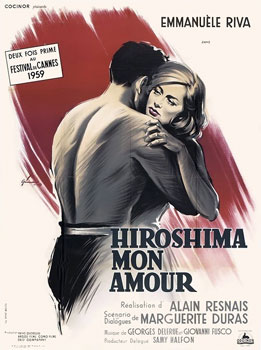
The late 1950s and early 1960s was a pivotal, heady, historic time for French cinema, as Nouvelle Vague or New Wave classics flowed onto the screen. Whereas Cahiers du Cinéma critic and enfant terrible François Truffaut’s reviews excoriating the state of France’s motion picture industry had previously gotten him banned from the Cannes Film Festival, in 1959 filmmaker Truffaut triumphantly returned, winning Cannes’ Best Director and OCIC Awards (as well as an Oscar nom) for his masterpiece The 400 Blows, a poignant picture about unhappy boyhood. In 1960 Breathless was released; its director, Jean-Luc Godard, is widely regarded as the New Wave’s most radical auteur, in terms of film form and leftw-ing politics. But Alain Resnais, whose Hiroshima Mon Amour was also nominated for Cannes’ 1959 Palme d’Or, certainly gave Godard a run for his francs, both cinematically and politically.
Resnais’ film, which won the FIPRESCI Award at Cannes bestowed by international film critics, has been long unavailable for theatrical screenings, but has now been restored and is being theatrically re-released in glorious black and white. Hiroshima Mon Amour is a groundbreaking work written with a novelist’s sensibility by Marguerite Duras (who, along with Resnais, scored Cannes’ Film Writers Award). Born and raised in Vietnam and Cambodia, Duras enhances this story about what Noel Coward would call a “brief encounter” between a French actress (Emmanuelle Riva as Elle) and a Japanese architect (Eiji Okada plays Lui). Elle is making a pro-peace film on location in postwar Hiroshima and the A-bombed city forms a backdrop to their love affair.
As for Hiroshima Mon Amour’s politics, it was quite daring to make an anti-nuclear film at that time, especially vis-à-vis U.S. audiences. To this day many Americans have an unexamined assumption that nuking Hiroshima, and then Nagasaki, was a vital — hence justifiable — factor in ending WWII, a rationale Elle gives voice to. But Resnais and Duras audaciously critique this rationalization (which Oliver Stone blew to smithereens in his recent Untold History of the United States documentary series for Showtime) and present the human face of atomic disaster. Viewers should be aware that there are a few gruesome shots that caused this writer to avert his eyes from the screen — but then again, nuclear war is no cotillion ball.
The nuclear nightmare has left its mark on Lui, although he was away from Hiroshima, serving overseas as a soldier, when the Enola Gay dropped its fatal, fateful payload on its civilian target, which included Lui’s family. Similarly, Elle’s experiences in occupied France during WWII made an enduring, indelible impression upon her. As a teenager she had a doomed romance with a German soldier at Nevers.
The Frenchwoman therefore has sex with men who were both on the opposing side during WWII (as Duras well knew, Japan and France vied over Indochina). Although not explicit by 2014 standards, the sexuality onscreen was bold in terms of 1959 aesthetics: At a time when professional virgin Doris Day held sway in Hollywood, it is clear that this interracial couple is engaging in and enjoying sexual intercourse in an artfully shot sensuous sequence.
In the existential mode, Hiroshima Mon Amour asks profound questions: Can love overcome the horrors of war? Sigmund Freud asked which is stronger: Eros (the life force) or Thanatos (the death instinct)? Or as “Dr.” George Carlin, that consummate master of wordplay, put it: “The person who thought up the slogan, ‘Make Love, Not War’… his job was over that day. He could’ve retired at that moment. If it would’ve been me, I would’ve walked away. So long, I’m goin’ to the beach. You guys work it out.”
Speaking of Freud, Hiroshima Mon Amour is also about the persistence of memory, and how it can rule and even terrorize our lives, long after those traumatizing events have taken place. Indeed, one could make the point that both characters, especially Elle, suffer from PTSD. The work’s film form, which deploys flashbacks and even flash forwards to a flashback (!), helps express these notions. Resnais continued to experiment with cinematic structure as late as his 2012 You Ain’t Seen Nothin’ Yet, made two years before his death in 2014 at the age of 91.
In 1959, the N.Y. Herald Tribune predicted Hiroshima Mon Amour “will still be important 50 years hence.” Well, today, as in 1959, this black and white, subtitled movie is not for everyone: Popcorn munchers hungry for mindless entertainment might want to move on to the next screen in the multiplex. Some 2014 viewers may even find the acting, storyline, etc., to be pretentious, too arty, too intellectual, perhaps even laughable.
But 55 years hence, for serious cinema students interested in fine films and movie history, Alain Resnais’ masterpiece remains essential viewing. In 1961 Truffaut and Godard co-directed the whimsical short A Story of Water, a romance about the flooding of a French village, which in retrospect could be viewed as metaphorical foreshadowing for how the New Wave inundated world cinema. And Hiroshima Mon Amour remains an essential ripple in this marvelous movie movement. I impatiently await the restoration (assuming it needs it) and re-release (which it surely needs) of Resnais’ other early Nouvelle Vague classic, 1961’s Last Year at Marienbad.
Hiroshima Mon Amour has been re-released in national distribution. To find out when it screens at a theater near you see: www.rialtopictures.com/hiroshima.










